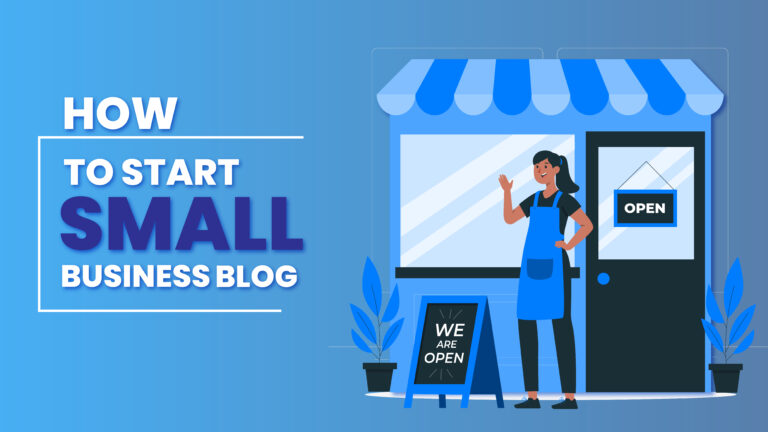To start a small business blog in 2026, begin by defining a clear and focused niche. A well-chosen niche helps you attract the right audience, stand out from competitors, and establish your authority in a specific area of the small business landscape. Popular niches include finance, digital marketing, operations, entrepreneurship, e-commerce, and productivity tools for small business owners. By leveraging your unique expertise or perspective within one of these niches, you can create high-value content that resonates deeply with your target readers.
A defined niche not only builds trust and credibility with your audience but also streamlines content planning and production. It ensures every article you publish is relevant, actionable, and aligned with your blog’s purpose, making it easier to grow your readership and improve search engine visibility in 2026’s competitive online environment.
What Is a Small Business Blog?
A small business blog is a dedicated digital platform where entrepreneurs and professionals publish educational, informative, and actionable content related to small business growth, operations, finance, marketing, and entrepreneurship.
These blogs help readers solve real-world problems, gain insights, and discover practical knowledge while positioning the blogger as an industry expert. In 2026, a successful small business blog integrates SEO, content strategy, user experience, multimedia elements, and long-form authority content.
Why Small Business Blogging Is a Strong Niche in 2026
Small business blogging remains one of the strongest niches due to consistent global demand for entrepreneurship guidance. With an increasing number of freelancers, online businesses, startups, and self-employed professionals, readers seek content that helps them start, manage, and grow their businesses.
In 2026, several factors will strengthen this niche:
High Search Volume: Topics like business planning, marketing strategies, financial management, and startup tools continue to trend.
Evergreen Demand: People always seek business advice, making the niche stable and timeless.
Strong Monetization Potential: This niche works exceptionally well with affiliate programs, digital products, courses, and consulting offers.
Authority Building: Publishing expert content helps establish trust and opens doors to partnerships and collaborations.
Best Small Business Blog Niches in 2026
Choosing the right niche determines the direction and success of your blog. In 2026, the strongest and most profitable business blogging niches include:
Business Finance: Funding, budgeting, grants, credit building, bookkeeping, and tax tips.
Digital Marketing: SEO, social media, branding, advertising, and content marketing.
Entrepreneurship: Startup planning, business ideas, case studies, and founder stories.
Online Business: E-commerce, dropshipping, SaaS, digital products, and freelancing.
Technology for Small Business: Tools, software, automation, and AI for business.
Operations and Management: Productivity, workflow, leadership, and team management.
Focusing on one niche helps build deeper topical authority critical for ranking in 2026’s advanced search ecosystem.
How to Start A Small Business Blog (Easy Steps)
1. Define Your Niche
To define your niche, conduct thorough market research. Analyze competitors, trends, and audience preferences. Utilize tools such as Google Trends, SEMrush, or Ahrefs to gauge interest in potential topics. For example, if you specialize in e-commerce, explore sub-niches like sustainable products or dropshipping.
Research Competitors
To research competitors, identify existing blogs in your chosen niche. Examine their content, audience engagement, and overall strategy. Platforms like BuzzSumo can help you analyze popular topics and influencers in your industry.
Identify Audience Preferences
To identify audience preferences, create surveys or engage with potential readers on social media. Tools like SurveyMonkey or Google Forms allow you to gather insights. Understanding your audience’s interests ensures your content remains relevant and engaging.
2. Choose a Blogging Platform
To choose a blogging platform, evaluate options such as WordPress, Wix, or Squarespace. Each platform has distinct features, pricing structures, and customization capabilities.
WordPress
WordPress is known for its flexibility and scalability. It offers a wide range of themes and plugins, allowing for extensive customization. Additionally, WordPress provides strong SEO capabilities, which are essential for increasing visibility.
Wix
Wix is recognized for its user-friendly interface and drag-and-drop functionality. This platform is suitable for beginners who prioritize ease of use. However, Wix may lack some advanced features compared to WordPress.
Squarespace
Squarespace is known for its visually appealing templates and design options. It offers a straightforward setup process, making it ideal for individuals focused on aesthetics. Squarespace may have limited third-party integrations, which could hinder scalability.
3. Select a Domain Name
To select a domain name, choose a name that reflects your blog’s niche and is easy to remember. Incorporate relevant keywords to improve search visibility. Tools like Namecheap or GoDaddy can assist in domain name registration.
Domain Name Tips
- Keep it Short: Short domain names are easier to remember.
- Use Keywords: Incorporate keywords related to your niche for better SEO.
- Avoid Numbers and Hyphens: These can lead to confusion and miscommunication.
4. Set Up Your Blog
To set up your blog, install your chosen blogging platform and customize its design. Utilize themes and templates that align with your brand’s identity. Customize the layout, colors, and fonts to create a cohesive look.
Install Essential Plugins
To enhance functionality, install essential plugins. For example, use Yoast SEO for search engine optimization, Akismet for spam protection, and Jetpack for performance enhancement. These plugins improve user experience and website efficiency.
Create Core Pages
To create core pages, include an About page, Contact page, and Privacy Policy. The About page introduces you and your blog’s purpose. The Contact page allows readers to reach out, while the Privacy Policy establishes transparency regarding data collection.
5. Develop Content Strategy
To develop a content strategy, create a content calendar outlining topics, publishing schedules, and promotional strategies. This organized approach ensures consistency and aids in audience engagement.
Content Types
To engage readers, incorporate various content types. Examples include:
- Blog Posts: In-depth articles exploring specific topics.
- Infographics: Visual representations of data or information.
- Videos: Short clips providing tutorials or insights.
SEO Optimization
To optimize for SEO, conduct keyword research using tools like Google Keyword Planner or Ubersuggest. Incorporate relevant keywords naturally within your content. Focus on optimizing titles, headings, and meta descriptions for better search visibility.
6. Promote Your Blog
To promote your blog, utilize multiple channels, including social media, email marketing, and networking. Share your content across platforms to reach a broader audience.
Social Media
To leverage social media, create accounts on platforms relevant to your audience, such as Instagram, Twitter, or LinkedIn. Share engaging content, interact with followers, and join relevant groups or discussions.
Email Marketing
To build an email list, create a signup form on your blog. Offer incentives such as exclusive content or discounts to encourage subscriptions. Use email marketing tools like Mailchimp or ConvertKit to manage your campaigns.
Networking
To network effectively, attend industry events, webinars, or online forums. Engaging with other bloggers and professionals can lead to collaborations and increased visibility.
7. Engage with Your Audience
To engage with your audience, respond to comments and messages promptly. Encourage discussions and feedback to foster a sense of community.
Create Polls and Surveys
To gather insights, create polls or surveys. Tools like Poll Everywhere or Typeform can help collect data on audience preferences. Engaging your audience in this way enhances loyalty and encourages return visits.
Host Webinars or Live Q&A Sessions
To further engage your audience, consider hosting webinars or live Q&A sessions. These events provide opportunities for direct interaction, allowing you to address questions and showcase your expertise.
8. Monitor Performance
To monitor performance, utilize analytics tools such as Google Analytics or SEMrush. Track metrics such as traffic, engagement, and conversion rates.
Analyze Data
To analyze data effectively, focus on key performance indicators (KPIs) relevant to your goals. KPIs may include:
- Traffic Sources: Identify where your visitors originate.
- Bounce Rate: Measure the percentage of visitors leaving after viewing one page.
- Conversion Rate: Track the effectiveness of your calls to action.
Adjust Strategies
To adjust strategies, analyze performance data regularly. If specific content types or promotional strategies yield better results, allocate more resources toward those areas. Flexibility allows for continuous improvement.
9. Monetize Your Blog
To monetize your blog, explore various income streams. Common options include affiliate marketing, sponsored content, and ad placements.
Affiliate Marketing
To implement affiliate marketing, partner with companies that align with your niche. Promote their products or services within your content, earning commissions for referrals. Platforms like Amazon Associates or ShareASale can facilitate affiliate partnerships.
Sponsored Content
To secure sponsored content opportunities, reach out to brands interested in collaboration. Create engaging posts highlighting their products or services, ensuring transparency with your audience. Sponsored content can provide substantial income while enhancing brand partnerships.
Ad Placements
To generate revenue through ad placements, utilize ad networks like Google AdSense or Mediavine. These platforms allow for automated ad placements, providing passive income based on traffic.
10. Stay Updated on Trends
To stay updated on trends, regularly research industry developments and emerging topics. Subscribe to relevant newsletters or follow industry leaders on social media.
Continuous Learning
To engage in continuous learning, participate in online courses or webinars. Platforms like Coursera or Udemy offer valuable resources on blogging, SEO, and digital marketing.
Network with Other Bloggers
To network effectively, join blogging communities or forums. Engaging with fellow bloggers allows for knowledge sharing and potential collaborations.
Conclusion
Starting a small business blog in 2026 requires a clear niche, a scalable platform, and consistently valuable content that meets user intent. Prioritize a strong content strategy, optimize for search engines, and build engagement through meaningful audience interaction. Promote your blog across multiple channels to expand visibility and authority. Track performance using advanced analytics to refine your approach and improve results over time. Explore diverse monetization options to turn your blog into a sustainable revenue source. Staying updated on industry trends and evolving digital practices will ensure your blog remains competitive and impactful in 2026 and beyond.
Frequently Asked Questions (FAQs)
What niche should I choose for my small business blog?
Choose a niche that aligns with your expertise and interests. Consider trends and audience preferences when defining your niche.
How often should I post on my blog?
Consistency is key. Aim to publish at least once a week, but adjust based on your capacity to create quality content.
Can I monetize my blog without a large audience?
Yes, monetization opportunities exist for smaller audiences. Focus on building relationships with niche brands and exploring affiliate marketing.
What tools can I use to analyze my blog’s performance?
Use tools like Google Analytics and SEMrush to monitor traffic, engagement, and conversion rates.
How can I grow my email list?
Offer incentives like exclusive content or discounts. Utilize signup forms and promote them on your blog and social media.


No Comments
Hi, i think that i saw you visited my site so i came to “return the favor”.I am attempting to find things to enhance my site!I suppose its ok to use some of your ideas!!
Your comment is awaiting moderation.